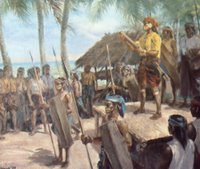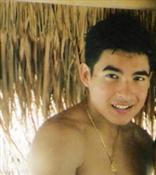Brief History of the Philippines
 Most Filipinos are a combination of Malay, Chinese, Negrito (native Filipino), and Spanish blood, but may also have a mix of Japanese and American. The racial mix originated from eras of differing foreign rule. The Negritos or Aeta ( the natives of the Philippines) were the original inhabitants of the islands. Following these hunter-gatherers was a breed that included the mix of Malays from deep southeast Asia. The Malays basically crept up starting from Mindanao. The muslim culture stemming from Mindanao was thus born from the Malay migration. The next to step foot on Philippine soil would be the Chinese, or those originating from east Asia, as they migrated across the sea and intermixed with the natives and Malays of the Philippines.
Most Filipinos are a combination of Malay, Chinese, Negrito (native Filipino), and Spanish blood, but may also have a mix of Japanese and American. The racial mix originated from eras of differing foreign rule. The Negritos or Aeta ( the natives of the Philippines) were the original inhabitants of the islands. Following these hunter-gatherers was a breed that included the mix of Malays from deep southeast Asia. The Malays basically crept up starting from Mindanao. The muslim culture stemming from Mindanao was thus born from the Malay migration. The next to step foot on Philippine soil would be the Chinese, or those originating from east Asia, as they migrated across the sea and intermixed with the natives and Malays of the Philippines.Horticulture and agriculture developed. Everything was relatively quiet until the 1500s when the Spaniards came upon the Philippines and desired to colonize it. Unfortunately for Spain, the Filipinos were not in the mood of being conquered. Ferdinand Magellan, a famous Spanish explorer credited for "discovering" the Philippines, was killed by Lapulapu, a famous Filipino chief credited for killing Magellan. Despite Filipino resistance, the Spanish eventually took over. Spanish rule over the Philippines would be a long one, from the 1500s to almost 1900. The Philippines' role as a key trade/base point was born. The Filipinos never did take a liking for Spanish rule, so they continued to rebel.
Jose Rizal, the national hero of the Philippines, is credited for sparking the series of Filipino rebellions during the 1800s. Rizal basically made a habit of writing Philippine nationalist papers, which the Spanish did not like at all. Around the same time, another hero was born in Andres Bonifacio. So Rizal sat back and wrote papers that angered Spaniards, while Bonifacio fought and led Filipino rebellions against the Spanish that also angered the Spaniards. And so Rizal was executed, and not long after, Bonifacio was too.
Emilio Aguinaldo took over as Filipino leader for a couple of years until the Spanish decided they wanted a ceasefire. Aguinaldo thought it was a good idea, so they organized an agreement that allowed Aguinaldo to go into exile and earn some money in the process. So at this point in time, the Philippines still technically belonged to Spain although Spaniard forces were taken out of the Philippines due to conflict in Cuba and with the US. The rebellions in the Philippines were at a standstill and Aguinaldo was out of the country spending Spanish pesos.
The US, being at war with Spain during this time, saw this as a great opportunity to snatch the vulnerable Philippines. And so they sought about doing just that by attacking what little of the Spanish navy was left in Manila. This influenced Aguinaldo to go back and declare independence for the Philippines . By now Spain no longer saw any point in wasting any more time with the Philippines so they sold the Philippines to the US for 20 million dollars. The US took over from there and set the Philippines with a puppet government suited to their liking. Rebellions still occurred but were not effective. The outbreak of World War II resulted in the Japanese invasion of the Philippines. After the war, a lease was signed to permit US bases in the Philippines.
The 1950s were relatively stable with the election of Ramon Magsaysay into power. Magsaysay tried to do good for the people but was lacking in funds. Ferdinand Marcos succeeded the throne during the 1960s and would keep the position until 1986. Macros took a good thing and got carried away with extremes. He proclaimed martial law to maintain his presidential position. Corazon Aquino followed as president at the end of Marcos' dictatorship.
The Philippines exhibited some growth during the 1990s under the leadership of Fidel Ramos. Declining to run for re-election Fidel Ramos was succeeded by actor Joseph Estrada. Estrada's term unfortunately resulted in rampant political corruption and economic decline, which prompted his impeachment.
Gloria Macapagal Arroyo followed as president of the Philippines. She was reelected in 2004, defeating actor Fernando Poe, Jr. However, she underwent scrutiny in 2005. She is accused of rigging the election, and although substantial evidence suggests that she did, she denies cheating. The Filipino people continue to seek for a solution to remove her from office.
Author: David Eric Poarch http://coconuter.blogspot.com/
Reference: Wikipedia



<< Home